The creator economy is booming in 2025, with more entrepreneurs and artists than ever turning ideas into profit. Digital product sales are skyrocketing as creators seek new revenue streams and greater independence.
But where to sell digital products for free and keep more of your hard-earned income? This guide reveals the 7 best platforms that let you launch, market, and sell digital products without upfront costs.
Explore unique features, transparent pricing, pros and cons, and the best use cases for each platform. By the end, you’ll have clear, actionable recommendations to help you choose the right marketplace and maximize your profits—no matter your niche.
What to Look for in a Free Digital Product Marketplace
Choosing where to sell digital products for free is a critical decision for creators and entrepreneurs. Not all marketplaces are created equal, and understanding what matters most can make or break your digital business success. Let’s break down the essential factors to consider before you commit to a platform.
Platform Fees and Pricing Transparency
The first thing to check when deciding where to sell digital products for free is how the platform handles fees and payouts. While many platforms advertise “free” selling, some rely on higher transaction fees or hidden costs that eat into your profits over time.
Here’s a quick comparison of common fee models:
| Platform | Upfront Cost | Transaction Fee | Notes |
|---|---|---|---|
| Gumroad | $0 | 10% | No monthly fee |
| Payhip | $0 | 5% | No listing fee |
| Ko-fi Shop | $0 | 0% | Payment processor fee |
| Itch.io | $0 | 0–10% | Flexible commission |
Look for platforms with clear commission rates and transparent payout structures. Over time, even a few percent difference can significantly impact your earnings. If you want a deeper dive into platforms, check out this Best websites to sell digital products resource for more insights.
Supported Digital Product Types
Not every platform supports the full range of digital goods. When considering where to sell digital products for free, review which product categories are allowed and whether the platform caters to your niche.
Supported product types often include:
- eBooks and PDFs
- Online courses and webinars
- Software, SaaS tools, and plugins
- Templates, graphics, and AI art
- Music, audio files, and soundtracks
Some platforms excel at niche offerings, like Itch.io for indie games or Ko-fi for art and music. If you’re selling AI-generated art, custom code, or audio packs, make sure your chosen marketplace can handle those formats.
Ease of Use and Store Customization
Your selling experience and brand image matter. The best answer to where to sell digital products for free often comes down to how quickly you can set up shop and how much you can customize it.
Look for these features:
- Intuitive onboarding and dashboard
- Customizable product and landing pages
- Integration with payment processors (PayPal, Stripe)
- Email marketing or newsletter tools
A user-friendly platform lets you focus on creating and marketing, not wrestling with tech headaches. Many platforms offer drag-and-drop editors or pre-built templates to get you started in minutes.
Audience Reach and Marketplace Exposure
Finally, consider the built-in audience and exposure each platform provides. Some marketplaces have millions of monthly active buyers, giving you extra visibility just by listing your products.
Key factors to weigh when evaluating where to sell digital products for free:
- Marketplace SEO and search features
- Community engagement tools (forums, reviews)
- Cross-promotion or bundle opportunities
Platforms like Gumroad and Itch.io feature strong organic traffic, while others rely more on your own promotion. If audience reach is a top priority, prioritize platforms with a proven track record of high marketplace traffic and active buyer communities.
7 Best Places Where To Sell Digital Products For Free In 2025
Looking for where to sell digital products for free in 2025? The options have never been more diverse or accessible. Whether you’re a seasoned creator or just starting out, these platforms offer powerful tools to help you launch, market, and profit from your digital goods—without the burden of upfront fees.
Below, you’ll find a detailed breakdown of the top 7 platforms, each with its own strengths, pricing, and ideal use cases. Compare their features, learn from real-world examples, and discover where to sell digital products for free based on your business goals.
Gumroad
Gumroad is one of the most popular answers when creators ask where to sell digital products for free. With no monthly fees and a straightforward 10% transaction fee on the free tier, Gumroad makes it easy for anyone to get started.
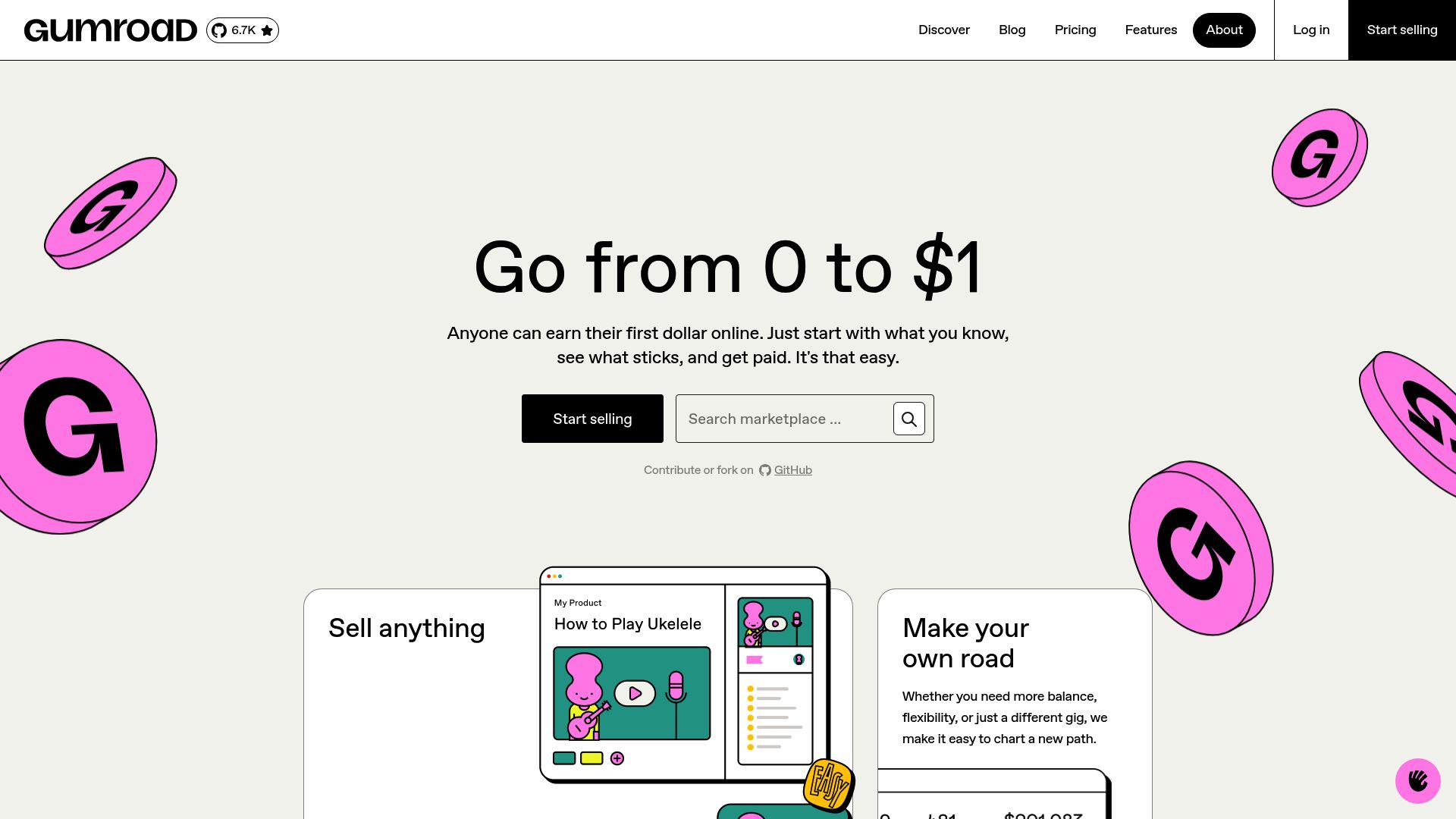
Core Features:
- Supports a broad range of digital products: eBooks, courses, music, software, and more.
- Simple storefronts with built-in analytics and email marketing tools.
- Customizable landing pages and direct payouts.
Unique Benefits:
- Affiliate management for boosting reach.
- Large, supportive creator community.
- Quick, hassle-free setup—ideal for those new to where to sell digital products for free.
Pros:
- No upfront cost.
- Easy onboarding.
- Supports multiple product types.
Cons:
- 10% transaction fee on the free plan.
- Limited advanced customization unless you upgrade.
Example: Many bestselling indie authors use Gumroad to launch eBooks without upfront investment, leveraging the platform’s built-in audience to maximize exposure.
Quick Comparison Table:
| Feature | Gumroad Free Tier |
|---|---|
| Upfront Cost | $0 |
| Transaction Fee | 10% |
| Product Limit | Unlimited |
| Audience Size | Large creator base |
| Customization | Basic |
If you want a reliable, no-fuss solution for where to sell digital products for free, Gumroad’s track record and community make it a top contender.
Payhip
Payhip is a go-to platform for creators searching for where to sell digital products for free, especially those targeting European markets. Its free-to-start model, with a 5% transaction fee, keeps things simple.
Core Features:
- Sell downloads, memberships, and courses.
- Automatic EU/UK VAT handling and full GDPR compliance.
- Built-in coupon codes and affiliate system.
Unique Benefits:
- Instant payouts and robust VAT support.
- Flexible product types, including digital art, courses, and coaching programs.
Pros:
- No listing or monthly fees.
- Excellent for handling European tax compliance.
- Easy to use, even for beginners.
Cons:
- 5% fee per transaction.
- Limited design customization on the free plan.
Example: Many European creators love Payhip for seamless VAT handling and selling digital courses to a global audience.
If you’re exploring where to sell digital products for free and need strong tax compliance, Payhip is a smart choice.
Ko-fi Shop
Ko-fi Shop stands out as a platform with 0% platform fees, making it an ideal answer to where to sell digital products for free for artists, musicians, and streamers with loyal followings.
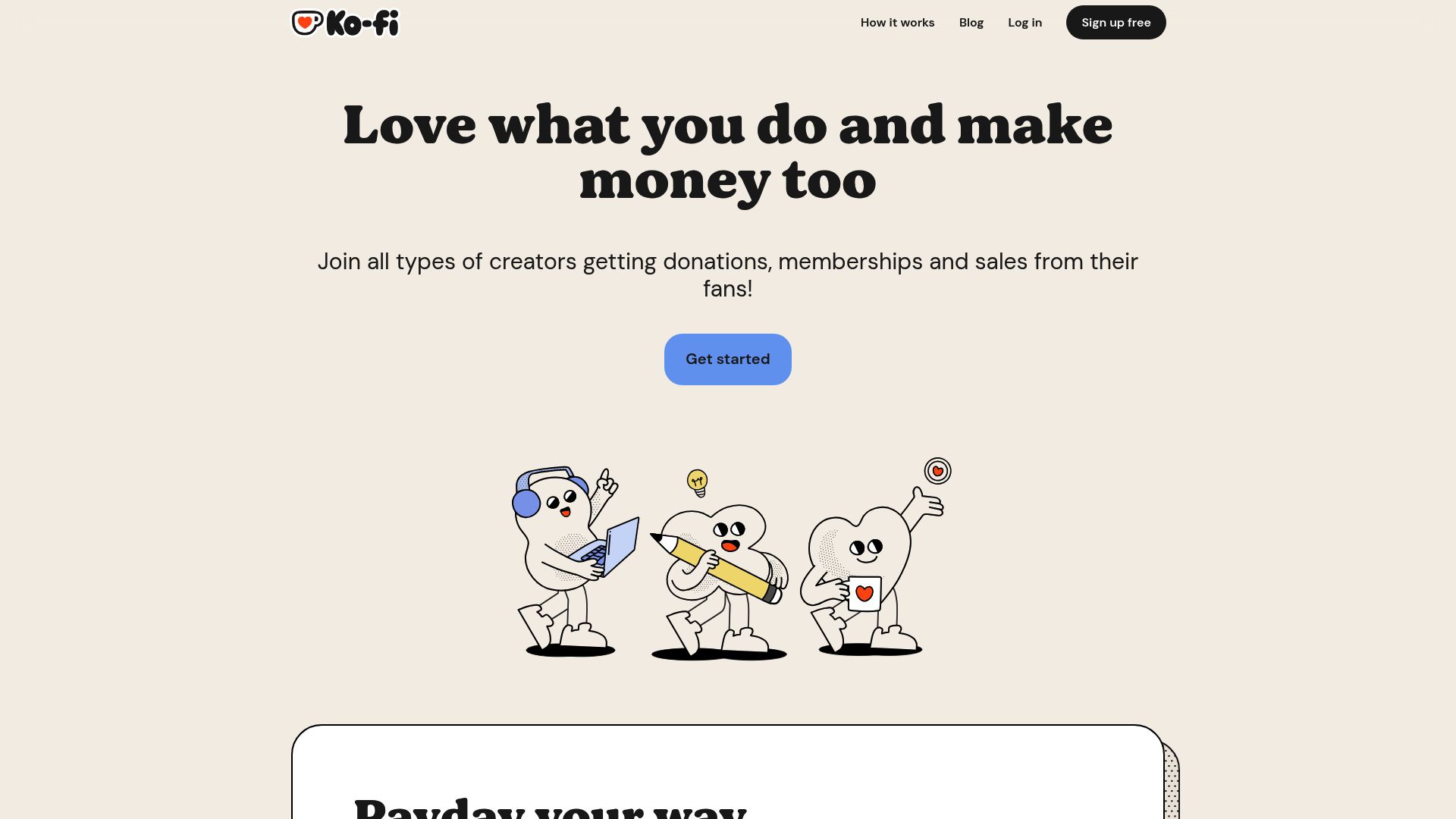
Core Features:
- Sell digital downloads, commissions, and memberships.
- Integrates a tip jar for fan support.
- Custom shop pages and social media integration.
Unique Benefits:
- No commission on sales—only payment processor fees (PayPal/Stripe).
- Strong community vibe and instant setup.
Pros:
- True zero platform fees.
- Perfect for creators with small product catalogs.
- Engaged, supportive audience.
Cons:
- Limited advanced e-commerce features.
- Best suited for smaller-scale digital product offerings.
Example: Artists use Ko-fi Shop to sell digital prints and music directly to fans, maximizing profits by avoiding platform cuts.
If you’re wondering where to sell digital products for free and want to keep more of your earnings, Ko-fi Shop is hard to beat.
Sellfy Free Plan
Sellfy’s free plan offers a compelling solution for creators asking where to sell digital products for free, especially if you have a limited product catalog. The free plan lets you list up to 10 products, with a 2% fee per sale.
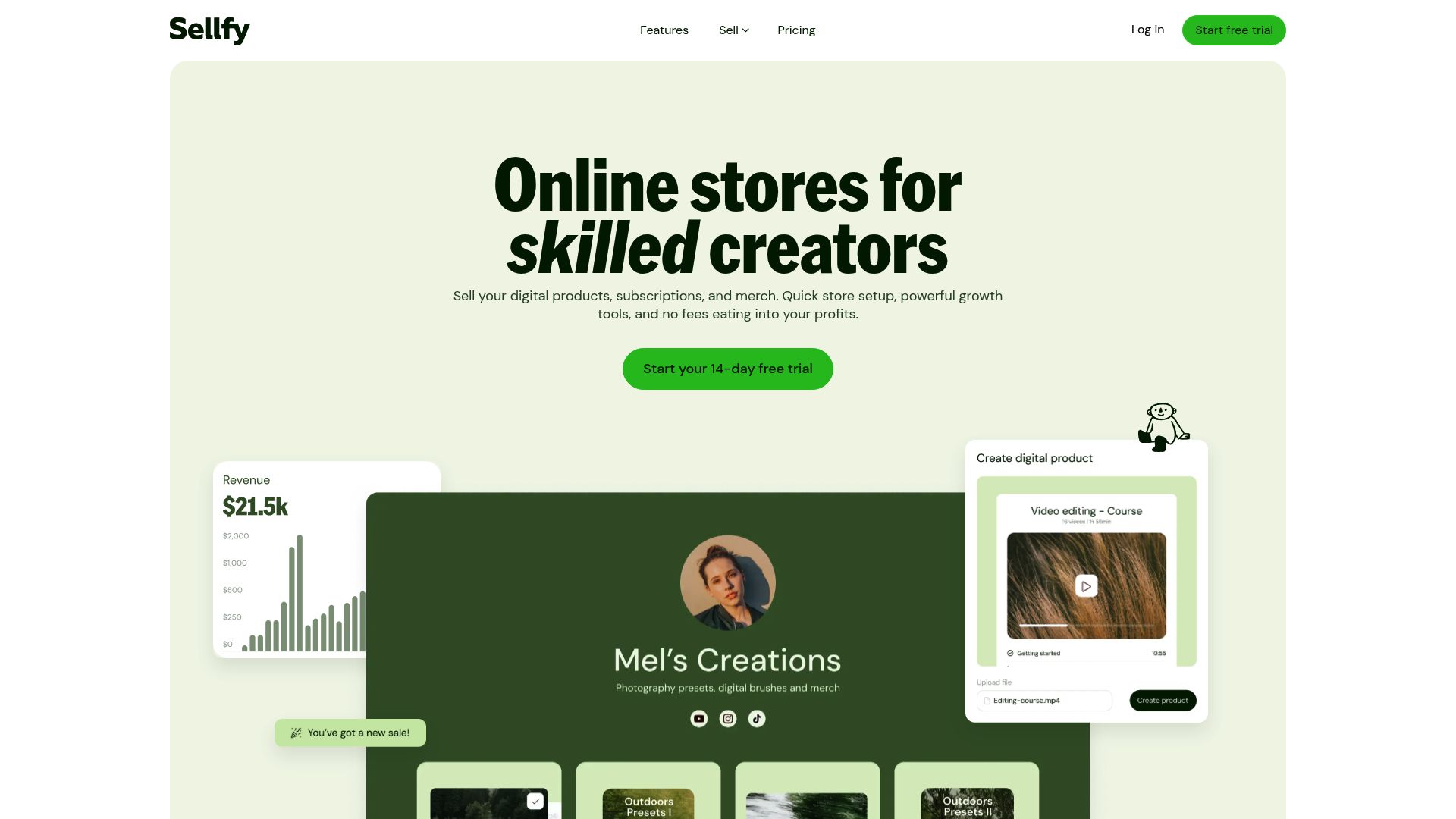
Core Features:
- Host digital products, offer customizable storefronts, and track analytics.
- Discount codes and embeddable “Buy Now” buttons.
- Print-on-demand options and video streaming support.
Unique Benefits:
- Seamless website and social media integration.
- Supports both digital and print-on-demand sales.
Pros:
- Free for small shops (up to 10 products).
- Easy to integrate with existing sites or YouTube channels.
- Modern, intuitive dashboard.
Cons:
- Product limit on the free plan.
- Higher fees and more features require upgrading.
Example: YouTubers use Sellfy to sell exclusive video content and templates, embedding links directly in their video descriptions.
If your main concern is where to sell digital products for free while maintaining control over your shop, Sellfy’s flexibility is a strong advantage.
Itch.io
Itch.io is a unique marketplace, especially for those in gaming and creative fields. For creators searching for where to sell digital products for free, Itch.io’s “pay what you want” commission model is exceptionally flexible.
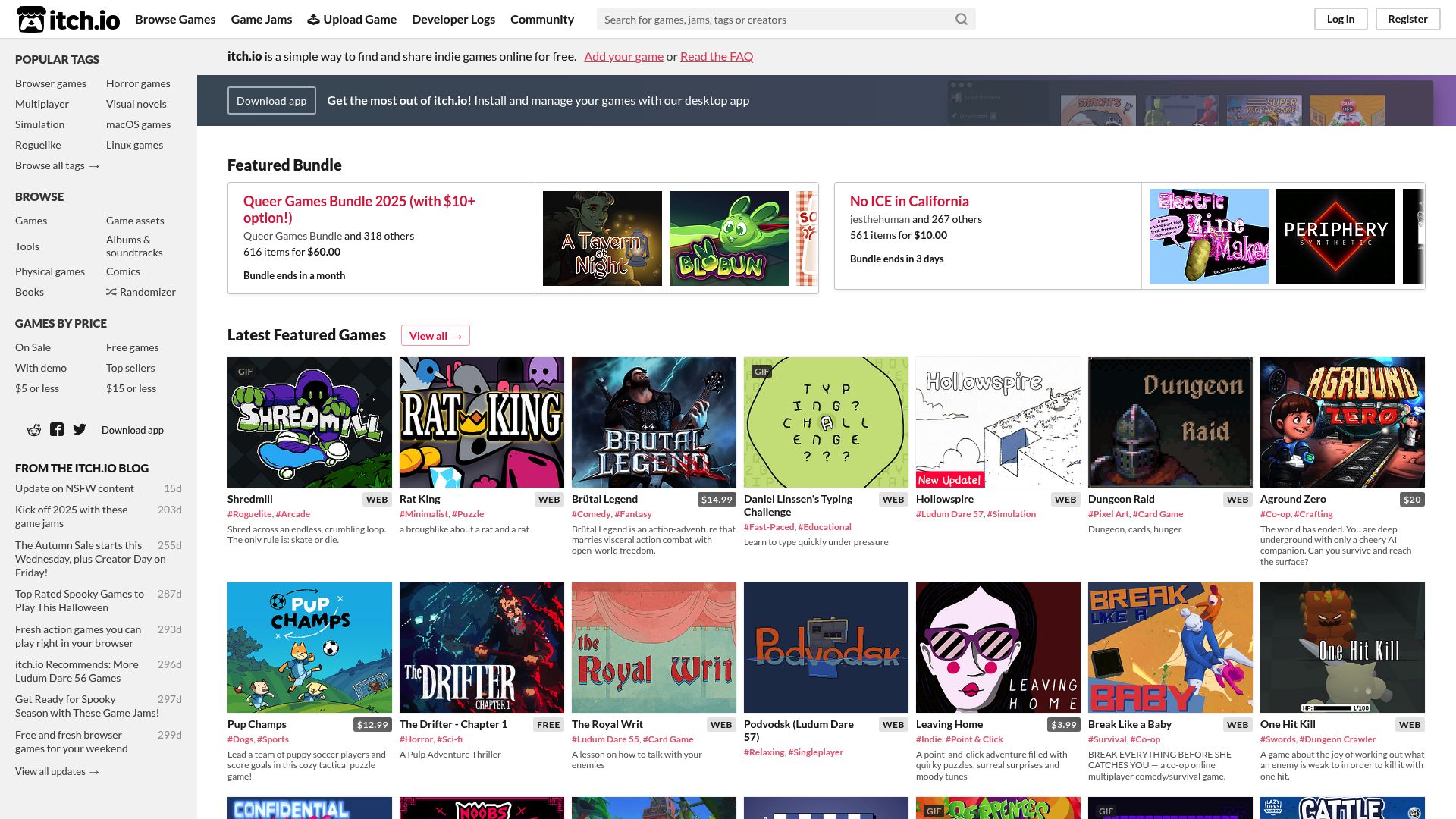
Core Features:
- Sell games, assets, music, and creative tools.
- Bundle creation and robust community features.
- Supports diverse formats and product types.
Unique Benefits:
- Set your own commission rate (default is 10%, but you can lower it to 0%).
- Vibrant, indie-friendly marketplace.
- Strong support for niche and experimental products.
Pros:
- Flexible fee structure.
- Community-driven exposure.
- Ideal for indie game developers and digital artists.
Cons:
- Best suited for gaming and creative niches.
- Limited reach for non-gaming digital products.
Example: Indie game developers and musicians thrive on Itch.io, launching games and soundtracks to a built-in, passionate audience.
If your focus is on where to sell digital products for free in creative or gaming spaces, Itch.io is tailor-made for you.
BigCartel Free Plan
BigCartel’s free plan is an excellent answer for artists and designers wondering where to sell digital products for free. The free tier allows up to 5 products, with no listing fees and only payment processor costs.
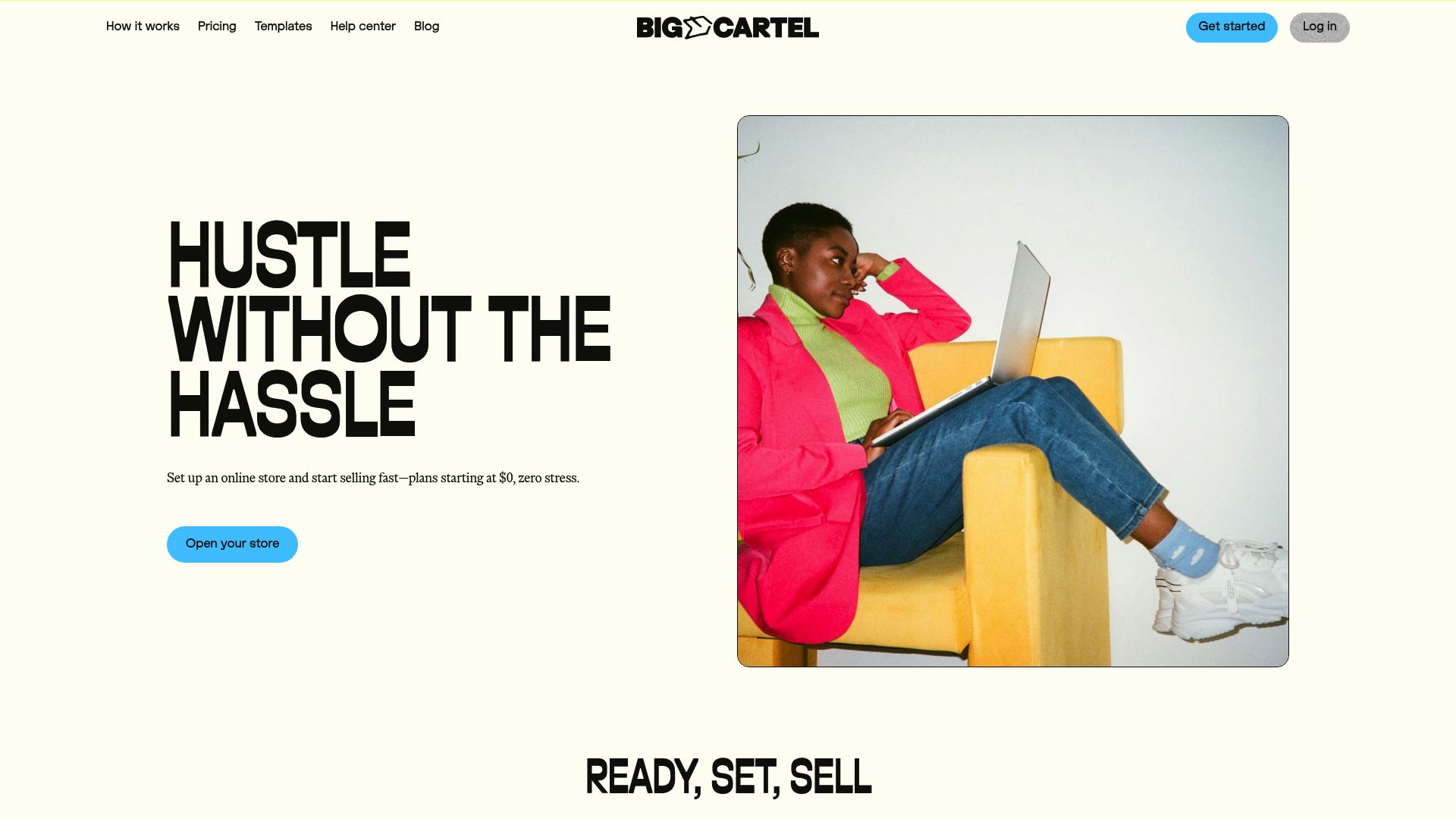
Core Features:
- Customizable storefronts for both digital and physical products.
- Basic sales analytics and artist-focused branding.
- No platform commission—just payment processing fees.
Unique Benefits:
- Super simple setup, perfect for small shops.
- Brand-friendly customization for artists and crafters.
Pros:
- No monthly or listing fees.
- Supports both digital and physical goods.
- Easy to use with minimal overhead.
Cons:
- Limited to 5 products on the free plan.
- Fewer advanced features compared to larger e-commerce platforms.
Example: Independent designers use BigCartel to sell digital art prints and posters, keeping costs low and branding front and center.
If you’re looking for where to sell digital products for free with a focus on art and design, BigCartel is a solid pick.
CreateSell
CreateSell takes a different approach for those seeking where to sell digital products for free. While not a traditional marketplace, it offers a freemium model packed with resources, educational courses, and automation tools to help you succeed.
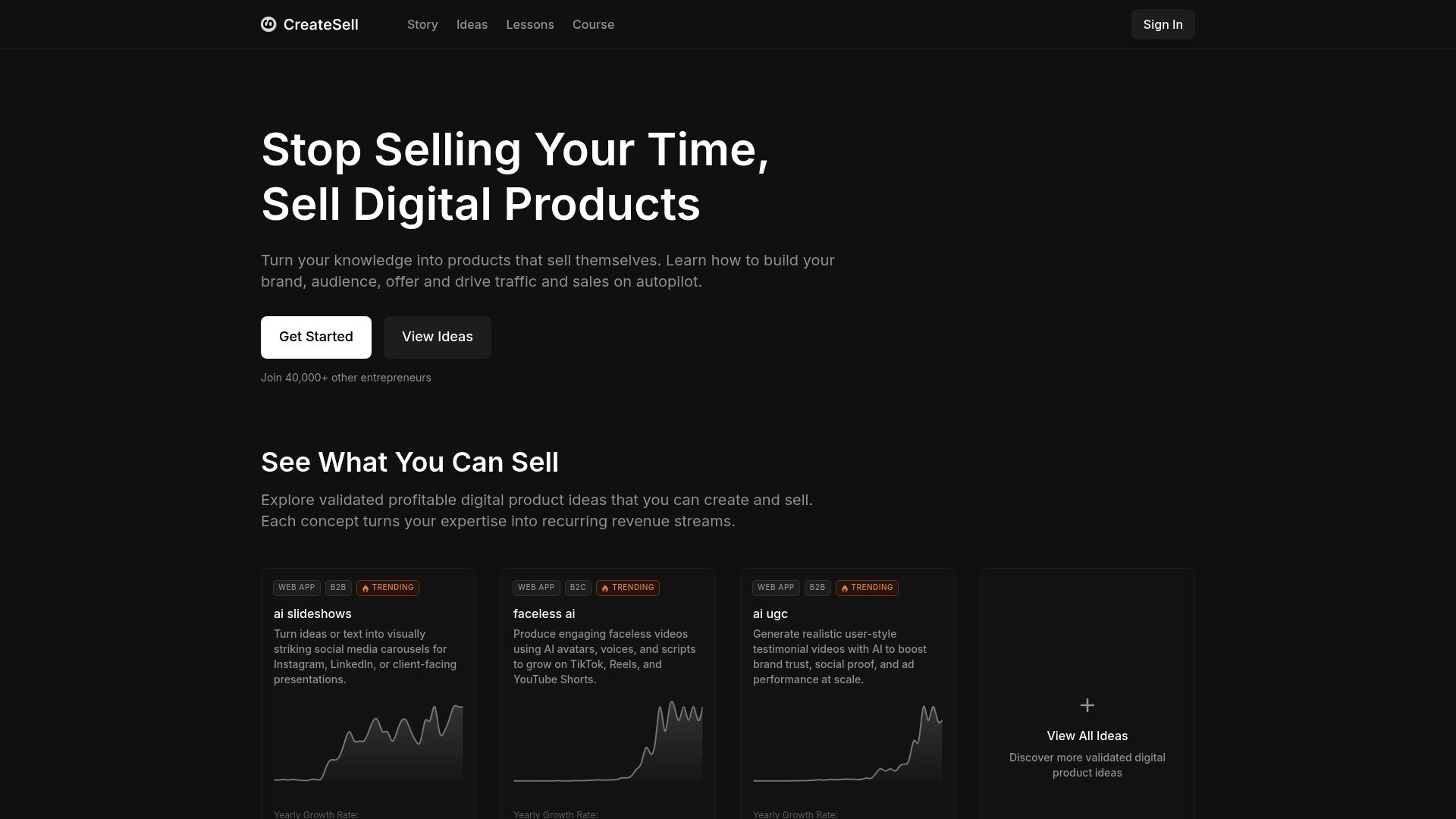
Core Features:
- Data-driven product validation and audience-building tools.
- Step-by-step launch guidance and automation strategies.
- Community support and actionable resources.
Unique Benefits:
- Focus on recurring revenue and building self-sustaining digital businesses.
- Thriving creator community.
Pros:
- Comprehensive education and support.
- Free access to foundational resources.
- Ideal for aspiring entrepreneurs and coaches.
Cons:
- Some advanced resources require a premium upgrade.
- Not a direct sales marketplace—focus is on enabling your own storefront.
Example: Entrepreneurs use CreateSell to validate product ideas, build audiences, and automate their sales funnels for long-term growth.
If you’re interested in more than just where to sell digital products for free—and want to build a sustainable digital business—CreateSell is a valuable resource. For an in-depth comparison of these and other platforms, check out this Best platforms to sell digital products 2025 guide.
How to Maximize Sales on Free Digital Product Platforms
Looking to boost your revenue on platforms where to sell digital products for free? Success comes down to optimizing every step, from your product listings to your marketing and analytics. Let’s break down the essential strategies to help you stand out, sell more, and turn browsers into loyal customers.
Optimize Product Listings for Discoverability
First impressions matter, especially when you’re figuring out where to sell digital products for free. Use keyword-rich titles and clear, engaging descriptions to make your listings stand out in crowded marketplaces.
- Incorporate high-quality visuals and product previews to grab attention.
- Use video previews—data shows listings with videos convert up to 30% higher.
- Highlight the value and unique benefits of your product in the first few lines.
For more actionable tips, check out this resource on how to sell digital goods online. Sellers who update images and descriptions regularly often see a significant increase in conversions.
Leverage Platform Marketing Tools
Maximizing sales on platforms where to sell digital products for free means making the most of built-in marketing features. Use email marketing tools to connect directly with customers and announce new releases or promotions.
- Offer coupons and run limited-time discounts to drive urgency.
- Tap into affiliate programs to expand your reach through partner networks.
- Bundle related products for greater average order value.
Take inspiration from Gumroad and Payhip, which offer robust marketing tools even on their free plans. These features help you attract new buyers and encourage repeat purchases.
Build and Nurture Your Audience
One of the best ways to sustain growth on platforms where to sell digital products for free is to actively build your audience. Focus on growing your email list, engaging on social media, and sharing valuable content to attract loyal fans.
- Start a newsletter to share updates, tips, and exclusive offers.
- Engage with buyers after purchase to encourage reviews and repeat sales.
- Remember, creators with 1,000+ subscribers see twice the repeat purchase rate.
For deeper strategies, read this guide on building an audience for digital products. The more invested your audience, the more consistent your sales will be.
Monitor Analytics and Iterate
Finally, don’t overlook the power of analytics on platforms where to sell digital products for free. Use built-in tools to track sales, customer behavior, and product performance.
- Regularly A/B test product pages, pricing, and visuals.
- Identify top-selling items and double down on what works.
- Sellers who iterate and refine their approach see over 20% sales growth.
Continuous improvement is key. Analyze what’s working, learn from your data, and adapt quickly to maximize your results.
Key Trends Shaping Free Digital Product Marketplaces in 2025
The landscape of where to sell digital products for free is evolving rapidly in 2025. Creators and entrepreneurs must keep pace with emerging trends to stay competitive and maximize profits. Let’s dive into the four key trends shaping the future of free digital product marketplaces this year.
Rise of AI-Powered Tools and Products
AI is transforming where to sell digital products for free by enabling new types of assets and automating creation. In 2025, platforms are rapidly adapting to support AI-generated templates, graphics, and even video content. According to digital product sales statistics 2025, AI-powered digital product sales have surged by 60% year-over-year.
- More creators are monetizing AI art, code, and automated tools.
- Marketplaces now offer tools to verify and manage AI-generated content.
- Buyers seek innovative assets that save time and boost productivity.
As demand grows, sellers on these platforms can leverage AI to expand their product offerings and reach new audiences.
Expansion of Micro-Entrepreneurship
The creator economy is seeing a boom in micro-entrepreneurship, directly influencing where to sell digital products for free. More individuals are launching one-person businesses, side hustles, and passion projects with zero upfront costs.
- Platforms are lowering barriers for first-time sellers.
- Flexible fee structures and no monthly charges attract small-scale creators.
- The number of new digital product sellers has surged since 2023.
This democratization means anyone with a skill or idea can join the market and start earning, making digital product sales accessible to all.
Enhanced Buyer Protection and Compliance
Trust is crucial when deciding where to sell digital products for free. In 2025, stricter regulations like VAT, GST, and GDPR are shaping platform features and compliance standards. Sellers benefit from built-in tax handling, secure checkout, and buyer protection tools.
- 80% of buyers now prefer platforms with robust compliance measures.
- Automated VAT/GST calculations simplify international sales.
- Marketplaces invest in payment security and refund policies.
Enhanced compliance builds trust and encourages more buyers to purchase, boosting sales for all creators.
Community-Driven Selling and Collaboration
Community has become a driving force in where to sell digital products for free. Platforms now foster peer-to-peer support, creator forums, and collaborative selling options.
- Joint product launches and bundles help creators reach wider audiences.
- Cross-promotion within marketplaces increases discoverability.
- Strong communities offer feedback, motivation, and networking.
For those looking to deepen their impact, resources like building digital products for profit can help you develop collaborative strategies and grow sustainably.
Now that you’ve seen the top free platforms to sell your digital products, you might be wondering how to actually take your first step—or maybe you’re looking for a bit more guidance on building your own digital product business from scratch. The good news is, you don’t have to figure it all out alone. If you want to learn proven strategies for growing your audience, automating your sales, and turning your knowledge into income, you can Get Started with free resources and expert advice tailored for creators just like you. This is your chance to move from idea to income—let’s make it happen!